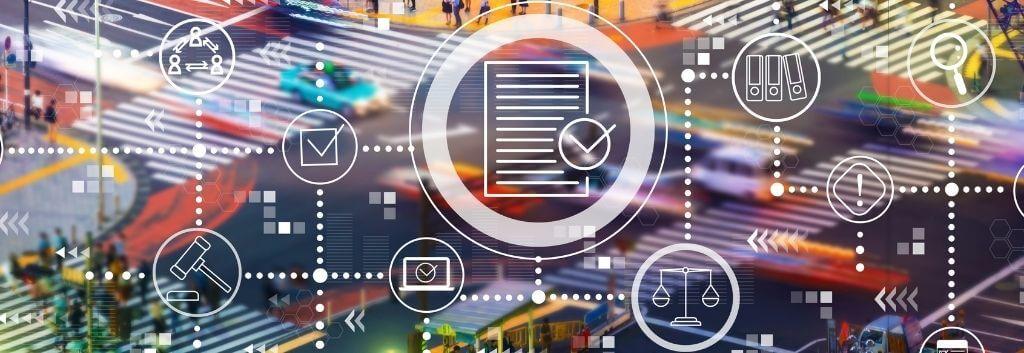
Autonomous driving that enables autonomous driving without a driver, which is a major revolution in road traffic. In order to realize these reforms, it is essential to revise the law, and it is necessary to create rules that correspond to the new society, including the establishment and abolishment of new regulations.
The social implementation of Level 3 and Level 4 autonomous driving technology is expected to begin in earnest soon, but what are the current laws and regulations? We will explain the laws surrounding autonomous driving.
Law to realize autonomous driving level 3
Road Transport Vehicle Law defines "automatic operation device"
In Japan, the Road Traffic Law, which stipulates traffic rules, and the Road Transport Vehicle Law, which stipulates safety standards for vehicles traveling on roads, were revised and enforced in April 2020, and level 3 driving on public roads is possible. became.
First, the Road Transport Vehicle Law stipulates that the automatic operation device, which is an autonomous driving system, is defined as a sensor that detects the state of the vehicle during operation and the surrounding conditions, which is necessary for automatically operating the vehicle by a program. and a computer and a program for processing information transmitted from the sensor as the main components", and "all of the abilities related to recognition, prediction, judgment and operation related to the operation of the vehicle operator and has a device to record the information necessary to confirm the operating state of the function,” and was added to the equipment subject to safety standards.
In addition, against the backdrop of the digitization and sophistication of automobile technology, it is now possible to change the performance of automobiles by updating software using communication. In addition to expanding to maintenance and changing the name to "specific maintenance", a permission system for remodeling by modifying the program incorporated in the automatic operation device etc. was also established.
Some of the safety standards and enforcement regulations have also been revised, and as a requirement for an automatic operation device, it is necessary to properly prompt the driver to operate when the driving environment conditions are not met, and to stop the vehicle safely if the driver does not comply. , a driver monitoring function that monitors the driver, and redundancy.
In addition, as a technical standard for vehicles equipped with a low-speed automatic operation device on highways, etc., the maximum speed at which the system operates is set at 60 kilometers per hour, and it is stated that the vehicle must remain in the driving lane. The operating status recorder will record changes in system operating status, the time when a handover request was issued, and the time when an override was performed.
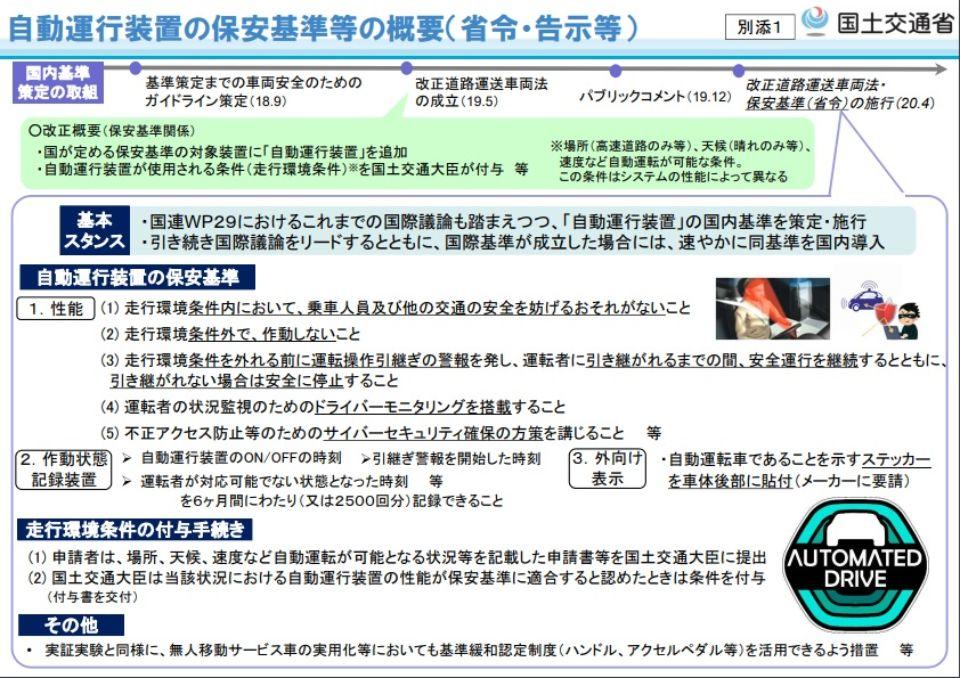
Safety standards for automated driving devices (Source: Ministry of Land, Infrastructure, Transport and Tourism "We have established safety standards for autonomous driving vehicles!")
Driving with an automatic operation device is also "driving"
On the other hand, while the Road Traffic Law stipulated the duty of safe driving on the premise that people were driving, the revision to allow Level 3 autonomous driving, such as defining driving with an "automated operation device" as "driving". It has been made.
In addition, regulations regarding the obligations imposed on drivers who use automatic operation devices and operating status recording devices are also in place.
These revisions legally recognized the existence and functions of Level 3 systems, making it possible to implement socially autonomous driving systems that meet the conditions.
Movement toward autonomous driving Level 4
Laws related to autonomous driving are not limited to the Road Traffic Law and the Road Transport Vehicle Law. A bill to partially revise the Road Act, etc. was also approved by the Cabinet in February 2020, and the facilities that assist autonomous driving are positioned as road accessories and private properties. Specifically, facilities for assisting the driving of autonomous driving cars and other similar facilities by means of electronic methods, magnetic methods, or other methods that cannot be recognized by human perception, such as magnetic markers. Equivalent to. If the revised bill is enacted, magnetic markers will be officially recognized as road accessories along with guardrails and curved mirrors.
It seems that there is also movement in the radio law. In addition to the enactment and promulgation of the revised Radio Law in 2019 for the smooth dissemination and advancement of the mobile communication system "5G", which is the foundation of Society 5.0, base stations that provide road-to-vehicle services and road-to-vehicle services and vehicles Regarding the 700MHz band intelligent transportation system, which consists of on-board equipment that uses vehicle-to-vehicle services, it seems that the addition of roadside machine communication (roadside communication) is being considered.
With the advancement of autonomous driving technology, it is expected that V2X technology such as road-to-vehicle communication (V2I) will be introduced in various fields, and further spread and evolution of ITS wireless communication technology is required. In addition to this, it seems that there is a move toward revision of the Automobile Liability Security Law (Automobile Automobile Law), which is necessary in the event of an accident.
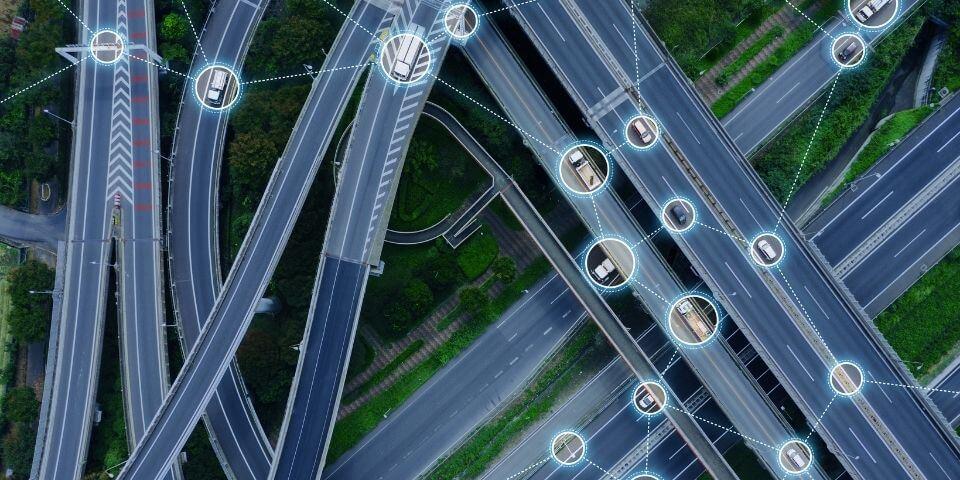
Guidelines to accelerate demonstration
National Police Agency Announces Guidelines for Promoting Demonstration on Public Roads
In 2016, the National Police Agency issued the "Guidelines for Demonstration Tests on Public Roads Related to Automated autonomous driving Systems" to promote the demonstration experiments that are essential to the realization of autonomous driving. In addition to formulating the standards for handling road use permission applications related to public road demonstration experiments of remote autonomous driving systems, the "road use permission standards related to public road demonstration experiments of autonomous driving" are also revised one by one.
- Guidelines for public road demonstration tests on automated driving systems
- Standards for handling road use permission applications related to public road demonstration tests of remote autonomous driving systems
- Criteria for permission to use roads for autonomous driving public road demonstration tests
In the guidelines, as a condition for public road demonstration experiments, a safety driver must sit in the driver's seat, constantly monitor the surrounding road traffic conditions and vehicle conditions, and perform necessary operations in an emergency. Guidelines are provided for the recording and storage of various data related to traffic accidents, measures to be taken in the event of a traffic accident, etc.
According to the handling standards for remote autonomous driving systems, demonstration experiments in which a remote driver uses telecommunications technology to drive a car can be conducted with permission to use roads under the Road Traffic Act. , standards for handling applications for road use permission related to public road demonstration experiments, such as the structure and safety assurance measures of remote autonomous driving systems, examination standards when one remote monitor/operator runs multiple test vehicles, etc. It is shown.
On the other hand, the latest version of road use permission standards related to public road demonstration experiments of autonomous driving includes remote type and special device vehicles that are operated with special devices different from normal steering wheels and brakes. .
Small-scale demonstrations in which a safety driver in the driver's seat securely manages operation can be conducted without special permission legally, but remote and special types require road use permission.
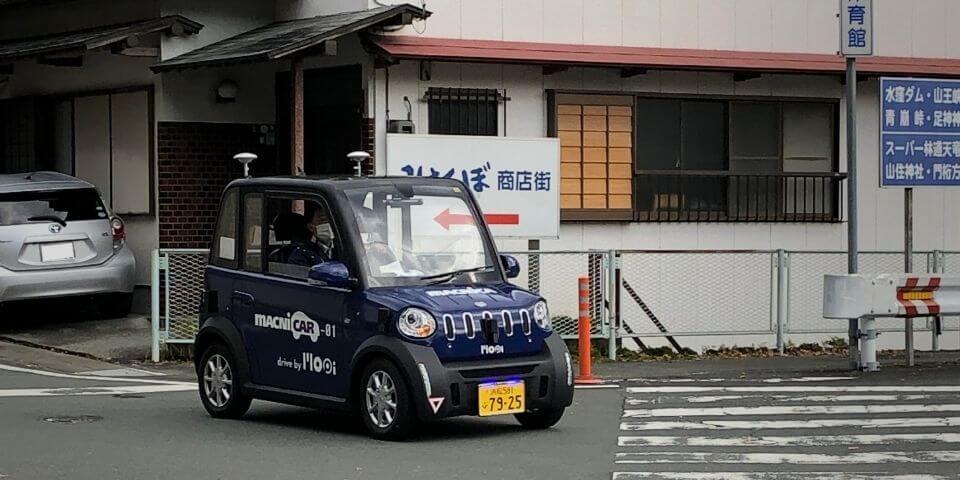
Hamamatsu city's public road demonstration test
Ministry of Land, Infrastructure, Transport and Tourism formulates safety technical guidelines
In addition to the guidelines for demonstration, the Ministry of Land, Infrastructure, Transport and Tourism has announced the Safety Technology Guidelines for Self-autonomous driving Vehicles, which summarizes the safety requirements and measures to ensure safety that autonomous driving vehicles must meet. The purpose is to promote the development and commercialization of autonomous driving cars that take safety into consideration.
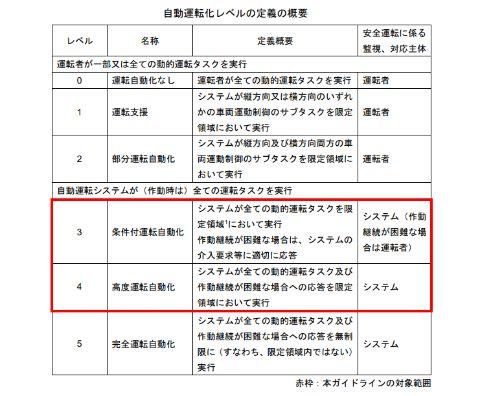
This guideline is for Level 3 and Level 4, setting ODD (Operating Design Domain) such as road conditions, geographical conditions, environmental conditions, safety of autonomous driving system, compliance with safety standards, system operation status Human Machine Interface (HMI) that conveys information to drivers, installation of data recording equipment, cyber security, safety of vehicles used for unmanned autonomous driving transportation services, safety evaluation to prevent foreseeable accidents, usage process It shows the basic concept of ensuring safety in automobiles and providing information to users of autonomous driving cars.
Establishment of international standards
International standards that affect the laws and regulations of countries around the world are also being enacted. The United Nations WP29 (World Forum for Harmonization of Vehicle Regulations) plays a central role in formulating standards, and Japan is leading the discussion, taking on positions such as co-chair.
At the March 2019 meeting, the following items were selected as priority items for consideration toward creating international standards for autonomous driving cars.
- autonomous driving framework (framework document)
- Functions required for autonomous driving such as HMI and driver monitoring
- New safety performance confirmation method
- cyber security
- software update
- Event Data Recorder (EDR)
- Data Recorder (DSSAD)
In June 2020, it was announced that agreement had been reached on automatic operation equipment, cyber security, and software updates as an international standard for Level 3. The automatic operation device is the same as the safety standard in Japan, such as an autonomous driving system limited to the lane keeping function that operates in traffic jams of 60 km / h or less on expressways.

autonomous driving and law enter a new era
The laws and regulations surrounding road traffic are steadily changing in anticipation of the advent of an autonomous driving society, and guidelines for accelerating the social implementation of autonomous driving technology and services are being developed.
Level 3 private cars and level 4 transportation services will soon be put into practical use, and their functions are expected to evolve further. We are stepping forward into a new era.
Inquiry
the Company, Macnica, provides a variety of products and services related to autonomous driving. If you have any questions or requests regarding autonomous driving, please feel free to contact us below.
